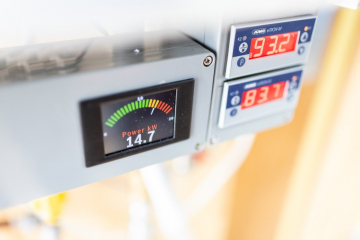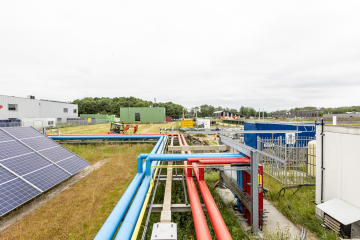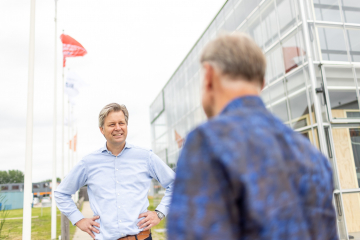Will green hydrogen be flowing through our natural gas pipelines in the future? Can the smallest molecule we know of help us to take major strides in the energy transition? All eyes are on Hoogeveen to deliver the answers to these questions. Here, in the world’s first hydrogen neighborhood, H2 must prove that it is a safe, comfortable and affordable alternative to natural gas. Three stakeholders update us on the state of affairs.
Known for his sayings that balance between the brilliant and banal, world-renowned Dutch soccer player Johan Cruyff once said that “something must first happen before something really happens”, an observation that, according to project manager Kees Boer of the Municipality of Hoogeveen, applies to the search for alternatives to natural gas. “There has been a great deal of talk about using hydrogen in the built environment; now it’s just a matter of putting it into practice. When we were approached about whether we would be interested in a hydrogen pilot in a residential area, we were immediately open to this.”

Hydrogen put to the test
It’s not that using hydrogen as an energy source is anything new: for decades hydrogen has been used to generate heat for industrial processes. Boer: “H2 is a great unknown in the built environment. Technically, there’s nothing standing in the way of hydrogen. Our natural gas grid is suitable for it and the first hydrogen-ready boilers have already been developed. The main challenge is to demonstrate that hydrogen in a home is just as safe, comfortable and affordable as natural gas.”
Whether this is actually the case is being put to the test in Hoogeveen, starting with a pilot in the new community of Nijstad-Oost, where about a hundred homes are being built. Boer: “The advantage is that in this neighborhood we can install all the infrastructure, including the hydrogen-ready boilers, in one go. This way we can demonstrate that it is technically feasible, safe and can provide comfortable homes. We then want to scale this up to encompass the adjacent community of Erflanden, a relatively new neighborhood with about four hundred homes. We are currently discussing this with the residents.”
“From transport and storage to distribution, every step has to be considered.”

The grassy area between the recreational lake Nijstad and the community of Erflanden is currently agricultural land, but if all goes well, groundbreaking can start here in just a year’s time. Much remains to be investigated in the meantime though. Kees Boer: “Tendering, zoning plans, laws and regulations: everything is slightly different. For example, under the Dutch Building Decree, it will need to be demonstrated that a hydrogen-fired boiler is comparable to a gas-fired boiler in terms of safety. And you have to design a new hydrogen supply chain too. The hydrogen for Nijstad-Oost will initially be supplied using tank trucks. From transport and storage to distribution, every step has to be considered. Fortunately, you do all of this with other parties; with a consortium of more than twenty partners, there is always plenty of expertise available.”
“Certainly in the older city districts, it is not economically feasible to fully insulate homes.”
Research in sustainable living lab EnTranCe
One of those partners is Hanze University of Applied Sciences Groningen. At its EnTranCe center of expertise for energy, the technical university is investigating the possibilities of hydrogen in the built environment. Business Developer Ted Wildenberg: “Certainly in the older city districts, it is not economically feasible to fully insulate homes. That means that heating with a heat pump is not a realistic option. Hydrogen transmitted through the existing gas network could offer a solution, however.”
Research has shown that this is not a pipe dream. Wildenberg: “The Dutch natural gas grid is in excellent condition. Slight modifications will be sufficient to be able to use this network for the transmission of hydrogen. There are certain issues to consider of course: hydrogen is more volatile than natural gas and, if there is a leak, it can escape more quickly. You can guarantee safety, however, with detection systems and regular checks for example.

Safety advantages
Wildenberg also sees the social acceptance of hydrogen as the biggest challenge. “Over the last 70 years, we [the Dutch] have become familiar with natural gas. Switching to hydrogen raises some questions: ‘Hydrogen, isn’t that oxyhydrogen gas that we experimented with during chemistry classes?’ ‘And the Hindenburg, the zeppelin that exploded over New York, wasn’t that filled with hydrogen?’”
That’s why it’s important to let people see for themselves that H2 is a safe alternative. In fact, it even has safety benefits. “The biggest safety issue with natural gas is the carbon monoxide that is created during incomplete combustion: this still causes an average of ten deaths [in the Netherlands] every year. Because hydrogen contains no carbon, you can eliminate the carbon monoxide hazard.”
Tiny house: two hydrogen systems
Seeing is believing. And that’s why a “Hydrogen Tiny House” is being built that will first tour the region and later the Netherlands. Antea Group is one of the parties involved in this, naturally in close collaboration with the municipality and Alfa College, the Hanze University of Applied Sciences and local businesses.

Antea Group’s engineers and consultants helped design two hydrogen installations. Jan-Lucas Hof: “One is the retrofit system where the traditional boiler has been replaced by a hydrogen-fired boiler. Once installed, the existing piping system and radiators can continue to operate as usual. This concept is being applied in the community of Erflanden in Hoogeveen.” And then there’s the tiny house, which is equipped with a self-sufficing system. Hof: “We use solar panels to generate electricity, which is then converted into hydrogen using electrolyzers. One of the major advantages is that you can store this hydrogen and use it as a buffer. By converting hydrogen back into electricity and heat through a fuel cell, you also have a sustainable energy in the fall and winter.”
Both systems clearly demonstrate the two major advantages of hydrogen. Hof: “With the retrofit system, you can repurpose the existing infrastructure to use hydrogen in the homes. The second system shows that it is possible to generate energy and then store it in the form of hydrogen as an energy buffer. This allows you as a neighborhood or community to go completely off-grid and be self-sufficient.”
Matter of necessity
However, a successful transition needs more than technology and social acceptance, Wildenberg concludes. “Hydrogen must also be affordable for the consumer. Laws and regulations are very important in this regard, to create space for hydrogen and to accelerate development in this area. In addition, to take this step it needs to become a matter of necessity. You can compare this to the introduction of LED lighting: it was only once the incandescent light bulb was banned that everyone quickly installed LED lamps in their homes and offices. Who knows, that may also happen with hydrogen.”
The hydrogen community: a diverse team builds and brainstorms
Many parties are involved in the development of the hydrogen community. The plan for the neighborhood came about thanks to a subsidy from the Netherlands Enterprise Agency (RVO). This plan is now being fleshed out by an implementation consortium comprising RENDO, Gasunie, NAM, Energie van Ons and The New Energy Coalition.
Hydrogen: Antea Group is helping pave the way
Hydrogen has everything it takes to become the driving force behind making industry, mobility and the built environment more sustainable. The opportunities are there, but there is still a lot to learn. Antea Group is taking the lead in developing knowledge on the generation, distribution and application of hydrogen. Our involvement in the Hydrogen Neighborhood is an example of this. Alongside the development of the tiny house, we are working on the tendering process for the hydrogen-ready boilers. We are also developing initiatives in-house to contribute to the hydrogen economy. For example, we launched the idea of building a solar-hydrogen power plant in Spain. We also help our customers along with aspects of the energy transition with, among other things, safety studies and permits for the application of H2, and we help them shape their strategic and tactical plans for making buildings, processes, residential areas and regions more sustainable.
